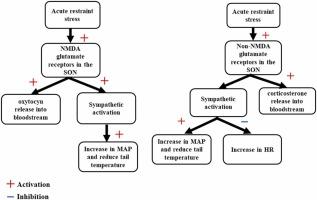Glutamate modulation of physiological and behavioral responses to restraint stress: Participation of supraoptic nucleus of the hypothalamus
IF 2.3
3区 心理学
Q2 BEHAVIORAL SCIENCES
引用次数: 0
Abstract
Aims
Acute restraint stress (RS) has been reported to activate the supraoptic nucleus of the hypothalamus (SON). The aim of the present study was to evaluate the role of glutamatergic neurotransmission in the SON on autonomic [mean arterial pressure (MAP), heart rate (HR), and tail cutaneous temperature], neuroendocrine (plasma levels of corticosterone, oxytocin, and vasopressin), and behavioral responses to RS.
Methods
Male Wistar rats with bilateral SON cannulas received microinjections of NMDA or non-NMDA receptor antagonists or vehicle before restraint stress, and the effects on cardiovascular, tail temperature, hormonal, and behavioral responses were evaluated
Results
Microinjection of DL-AP7 or NBQX into the SON reduced MAP increases and tail temperature decreases induced by RS. Also, NBQX enhanced RS-evoked tachycardia. SON treatment with DL-AP7 or NBQX reduced RS-induced increases in oxytocin, without affecting vasopressin plasma levels. Morever, NBQX enhanced RS-induced increases in plasma corticosterone level. DL-AP7 inhibited the RS-caused delayed anxiogenic-like effect.
Conclusion
NMDA and non-NMDA glutamate receptors in the SON facilitate pressor response and oxytocin release during RS. In addition, non-NMDA receptors exert an inhibitory influence RS-induced increases in heart rate and corticosterone release, whereas NMDA receptors contribute to the delayed expression of anxiety-like behaviors.

谷氨酸调节抑制应激的生理和行为反应:下丘脑视上核的参与
目的:急性约束应激(RS)可激活下丘脑视上核(SON)。本研究的目的是评估谷氨酸能神经传递对自主神经[平均动脉压(MAP)、心率(HR)和尾皮温度]、神经内分泌(血浆皮质酮、催产素和加压素水平)和对rs的行为反应的作用。方法双侧SON插管的Wistar小鼠在约束应激前接受微注射NMDA或非NMDA受体拮抗剂或载药,观察其对心血管、结果将DL-AP7或NBQX显微注射到SON中,可降低RS诱导的MAP升高和尾温降低,NBQX可增强RS诱发的心动过速。用DL-AP7或NBQX治疗SON可降低rs诱导的催产素升高,而不影响加压素血浆水平。此外,NBQX增强rs诱导的血浆皮质酮水平升高。DL-AP7抑制rs引起的延迟性焦虑样作用。结论SON中NMDA和非NMDA谷氨酸受体促进应激反应和催产素释放,非NMDA受体对RS诱导的心率和皮质酮释放增加具有抑制作用,而NMDA受体参与延迟焦虑样行为的表达。
本文章由计算机程序翻译,如有差异,请以英文原文为准。
求助全文
约1分钟内获得全文
求助全文
来源期刊

Behavioural Brain Research
医学-行为科学
CiteScore
5.60
自引率
0.00%
发文量
383
审稿时长
61 days
期刊介绍:
Behavioural Brain Research is an international, interdisciplinary journal dedicated to the publication of articles in the field of behavioural neuroscience, broadly defined. Contributions from the entire range of disciplines that comprise the neurosciences, behavioural sciences or cognitive sciences are appropriate, as long as the goal is to delineate the neural mechanisms underlying behaviour. Thus, studies may range from neurophysiological, neuroanatomical, neurochemical or neuropharmacological analysis of brain-behaviour relations, including the use of molecular genetic or behavioural genetic approaches, to studies that involve the use of brain imaging techniques, to neuroethological studies. Reports of original research, of major methodological advances, or of novel conceptual approaches are all encouraged. The journal will also consider critical reviews on selected topics.
 求助内容:
求助内容: 应助结果提醒方式:
应助结果提醒方式:


